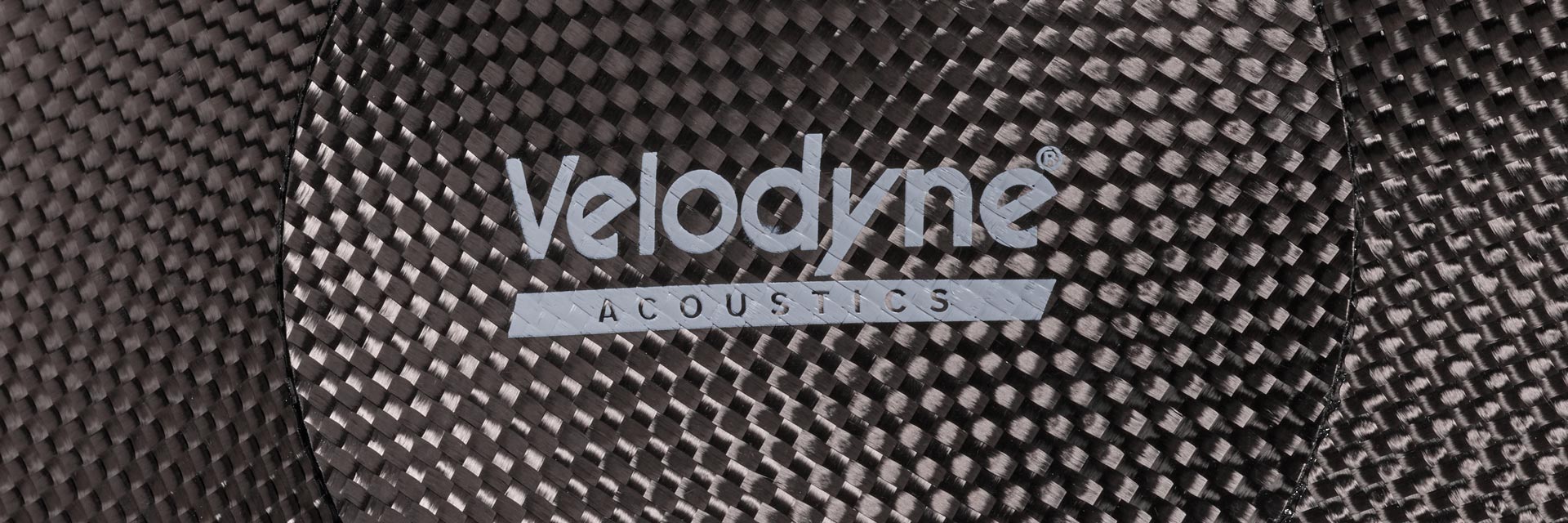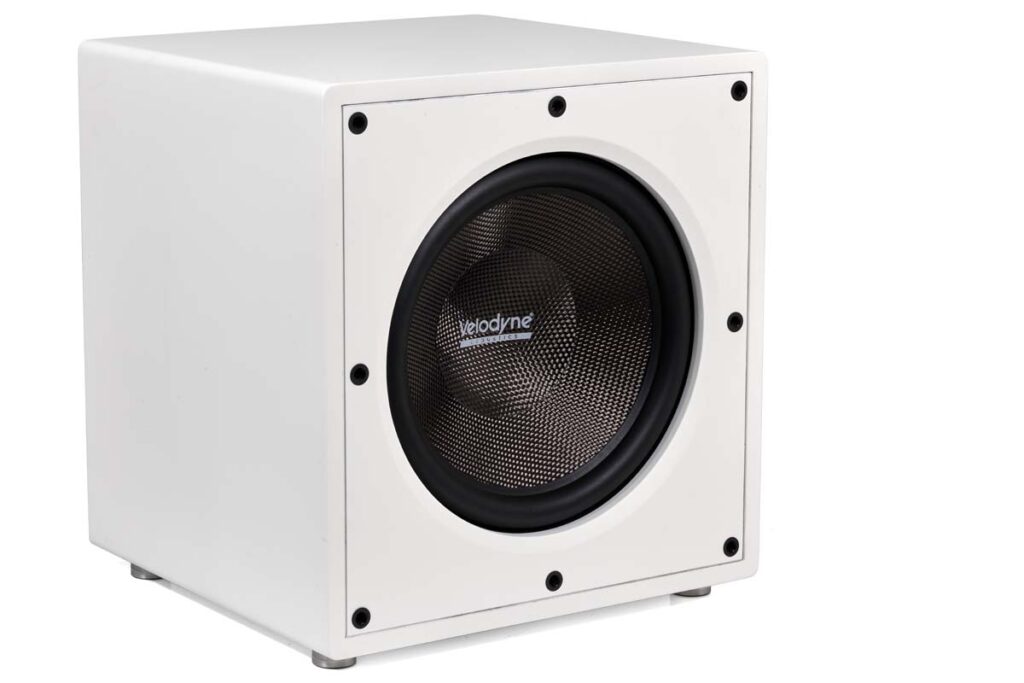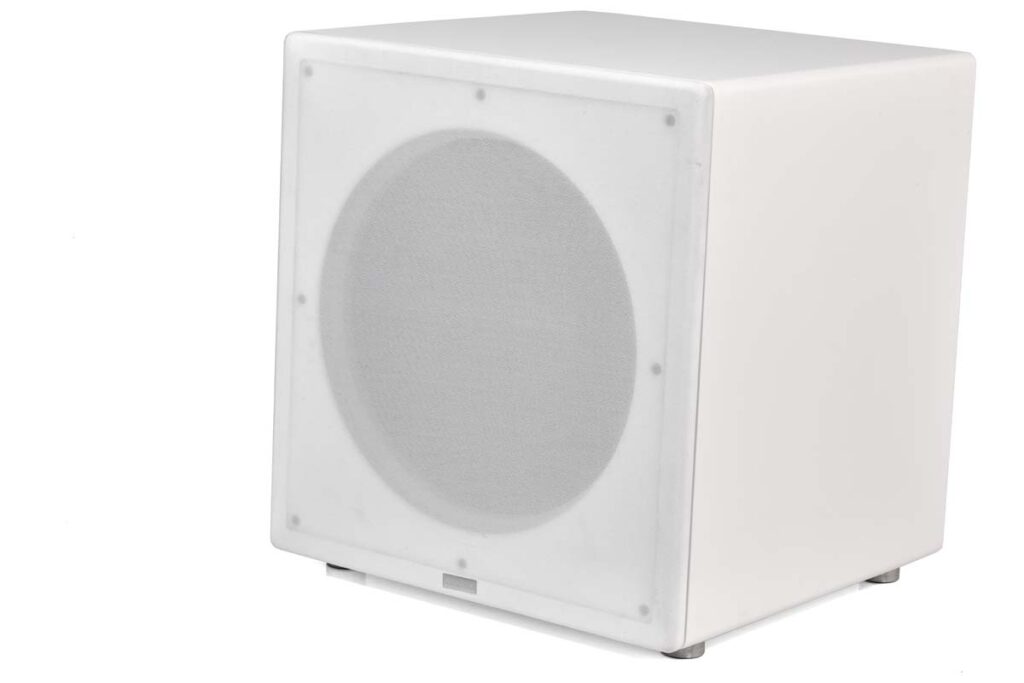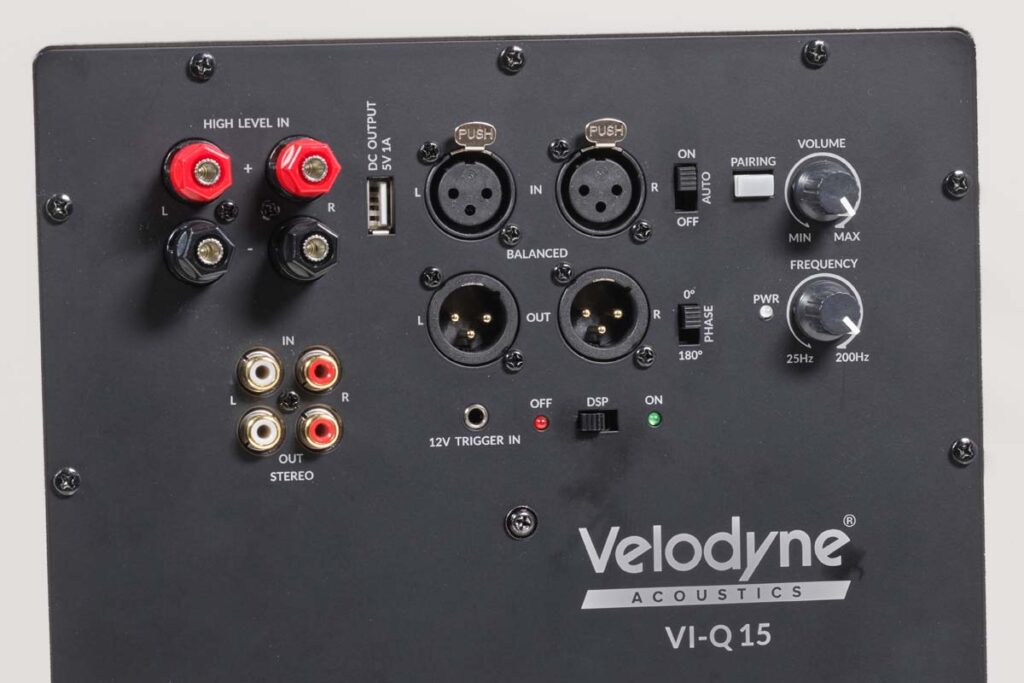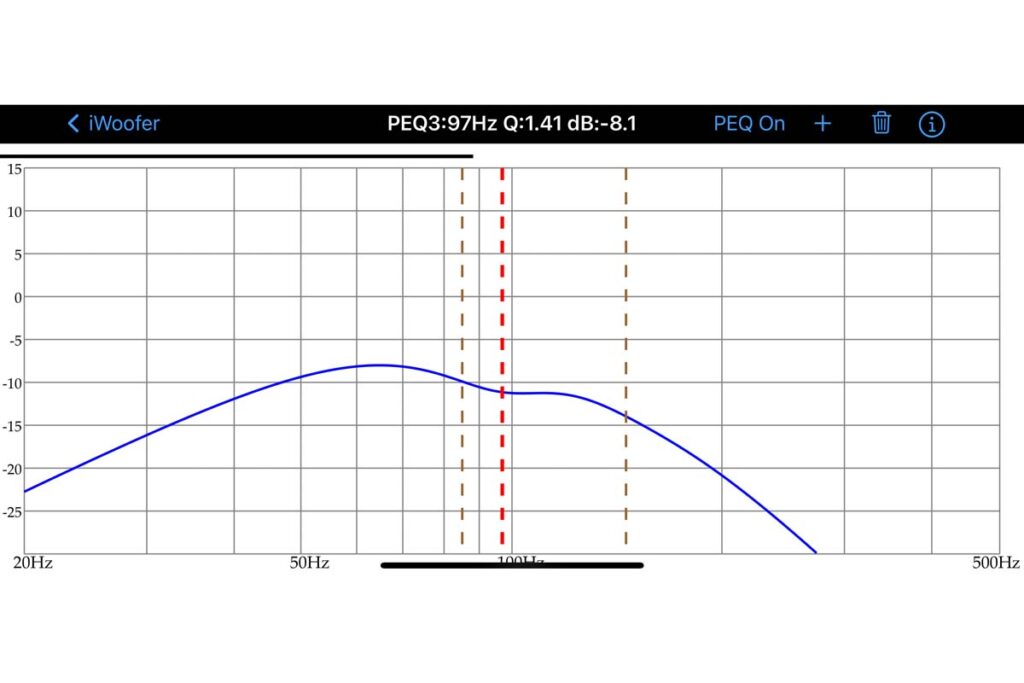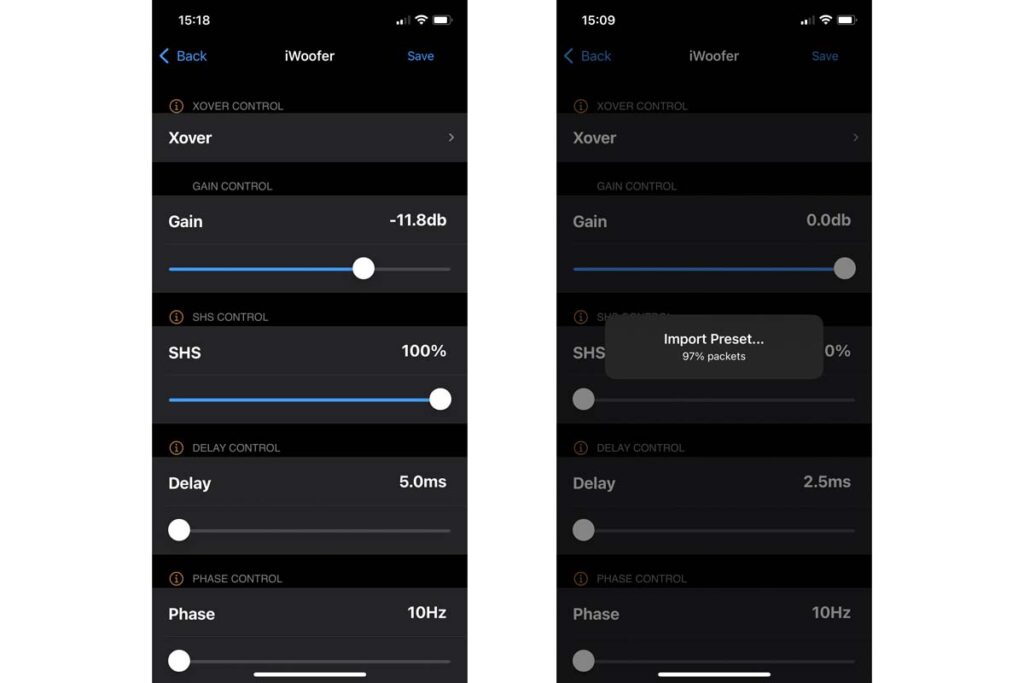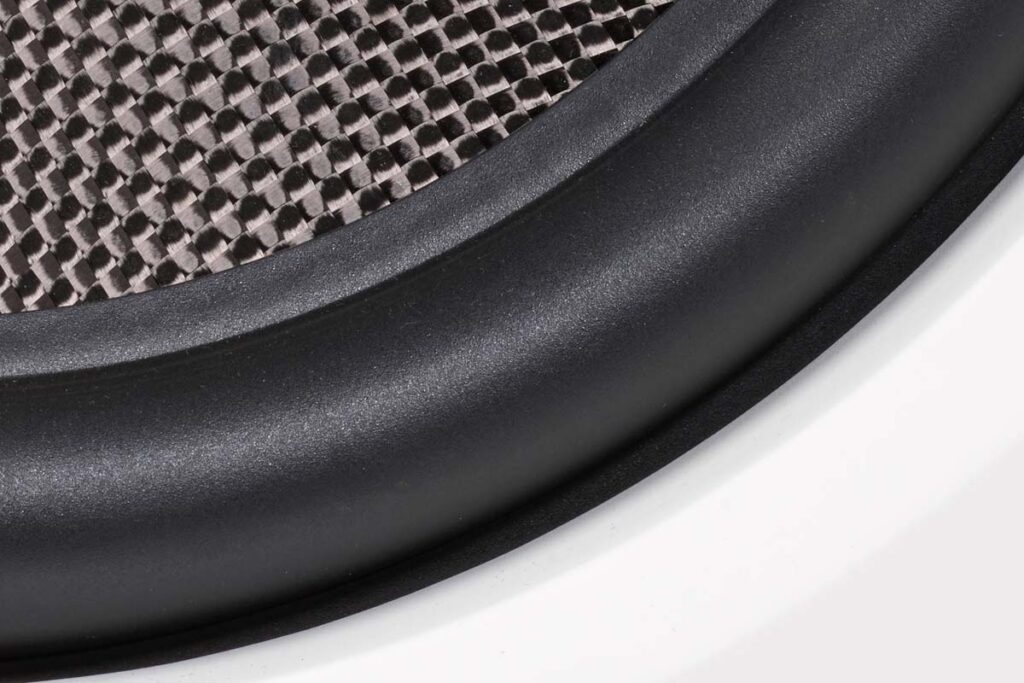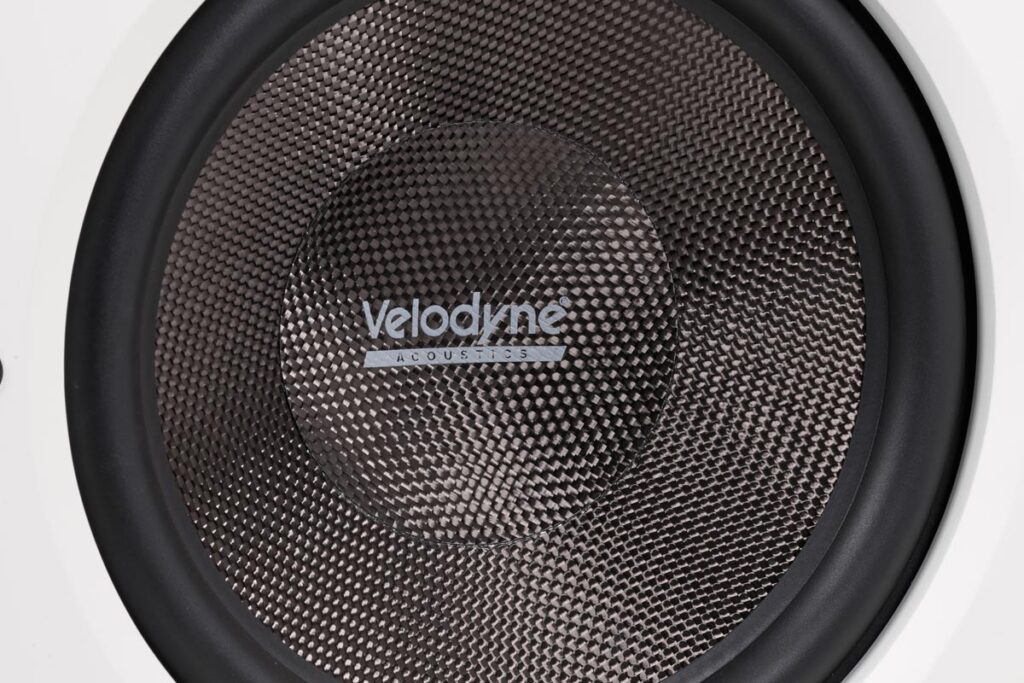You can’t hear a properly adjusted subwoofer – a shame, really. Sure, you can make the Velodyne VI-Q 15 disappear in the best sense of the word if that’s what you want, but its diverse connection and control options plus plenty of displacement also encourage experimentation and playing around.
To start with, let me get one thing out of the way: although certainly not on the shy side, the Velodyne VI-Q 15 is by no means intended as a pure home theater powerhouse. The 15-inch driver has plenty of elbow room in its spacious housing, but you will look in vain for bass reflex channels or passive radiators. Transient response and control were clearly just as much among the design goals as depth and authority. This is evidenced not only by the sealed box design but also by the use of carbon fiber composite as the cone material, which is known for its rigidity and extremely low weight. At first glance, this may sound counterproductive in the context of a subwoofer – after all, the driver in a speaker cabinet behaves like a mass-spring system: the greater the mass, the lower the natural frequency of the system and the deeper the woofer can dig accordingly. Velodyne has simply and elegantly added back the cone’s mass deficiency on the drive side in the form of a four-layer, three-inch diameter copper voice coil, thus concentrating the desired moving mass on the controlling rather than the controlled side – perfect preconditions for a tidy response even at high excursions.
Speaking of which: A Class D power amplifier with 650 watts of continuous and 1200 watts of impulse power acting on a motor system with two generously dimensioned ferrite magnets provides oodles of driving force. To ensure that only the cone moves in the face of such forces, a solid, well-braced cabinet is of course a must. The HDF construction with a 50-millimeter-thick multiplex baffle is really just par for the course for such a device. However, the fact that Velodyne leaves nothing to chance when it comes to mechanical stability can be seen in cute details such as the driver surround: instead of simply screwing the chassis to the baffle – 50 millimeters of multiplex offer plenty of space for the threads – an HDF ring clamps the chassis in place from the rear so the bolts evenly tighten the rim of the basket down over the entire radius from both sides. Similarly, Velodyne doesn’t rely on a magnet system to snap on the front grill, but went for a mechanical connection via pegs instead – clearly, the developers have the utmost respect for the sheer power of their own creation.
Proven math-brain
The Velodyne VI-Q 15 is no doubt a “more is more” subwoofer – but this is not immediately apparent when looking at the rear panel. Not that it’s bare-bones: Inputs are via RCA (stereo or LFE), XLR or high-level input, plus there are RCA and XLR outputs, and a trigger connection is also available. However, the setting options are (at least apparently) limited to the crossover frequency and volume level; the phase can only be inverted via toggle switch. In the past, Velodyne’s connection panels in particular have been much more comprehensive. However, this is just a sign of our times: a large part of the functionality has simply been moved to an app, thanks to DSP and wireless connectivity.
Originally, the idea was to develop this in-house, but as an interim solution, the company decided to implement support for the tried and tested iWoofer app, which is available for iOS and Android devices. However, this supposed stopgap measure quickly proved to be perfectly comprehensive, competent and convenient. The realization that an in-house developed app wouldn’t offer any added value to speak of followed quickly, and so the in-house app developers just shrugged and proceeded to integrate iWoofer as the permanent official control method without further ado. You could raise an eyebrow at this point, as iWoofer is a freemium app where only the basic version is free of charge. However, a voucher for the paid version comes with every VI-Q 15 purchase.
The paid version is only available for iOS users anyway, as the extended functionality essentially entails automatic room calibration using low latency FIR filters – and this takes advantage of the fact that all Apple devices have been using the same microphone for generations, whose frequency response is a known quantity and can therefore be “blindly” linearized.
But even without room calibration, iWoofer offers a generous range of functions: gain and crossover frequency can be infinitely adjusted using the slider, as can time delay and phase. The star of the show, however, is undoubtedly the parametric equalizer with up to 25 (in words: twenty-five) bands. As a rule, three or four will of course suffice to shape the subwoofer curve as desired with a swipe of the finger on the touch display – above a dozen or so control points, the whole thing not only becomes very confusing, but also slows down considerably – but it’s nice to know that you can go nuts if you so desire.
A nice gimmick is the Subharmonic Synthesizer (SHS), which, as the name suggests, adds subharmonics to the bass below the fundamental frequency to help older recordings whose driving rhythms tend to be on a shaky footing. It’s not just an on/off-affair either, but can be added to taste. Try it out on “YYZ” by Rush (Moving Pictures), for example – a fantastic instrumental track that reliably makes high-end systems sound like kitchen radios. I would only use SHS in “emergencies” like this, but in these cases I am more than happy to be able to experience the performance with a bass foundation.
Bass and soundstage
Speaking of listening to music: As usual, I try a song with a sonorous voice to dial in the settings – this time the choice falls on The Hillbilly Moon Explosion with “My Love For Evermore” from their 2011 album Buy, Beg Or Steal. In the duet with front woman Manuela Hutter, Mark “Sparky” Phillips in particular provides clear indications of the right crossover frequency with his beautifully grumbling voice.
The A/B comparison with and without the subwoofer immediately reveals the well-known subwoofer effect that never fails to astonish: the difference is not so much in the tonality, but all the more so in the soundstaging. Hutter’s and Phillips’ voices move a good half meter apart, only now does it become really obvious that the singer is not placed in the center, but slightly to the left. The drum kit and bass now appear much further back on the stage.
It all sounds pretty convincing, but I get a feeling that the VI-Q 15 is low-key keen on delivering more, so I put on Wednesday Campanella’s “Melos” (Galapagos) – a piece that somehow manages to make a constant back-and-forth between bossa nova and mainstream electro noises sound completely natural, but above all features a very weighty rhythm section. The bass expansion is readily apparent: The way the mighty drum beats come in hard and punchy, is pure bliss. And here, too, the room really opens up: In addition to fat drums, the track hurls a myriad of claps, snaps and other percussive sounds all across your ears, and they fan out much wider and deeper with sub support.
The fact that I’m having a great time tells me that the subwoofer is doing equally well – it masters the role of the unnoticed bass butler, but at its core the Velodyne VI-Q 15 is a subwoofer that wants to make itself heard. Well, I’m happy to oblige, so I turn it up another three decibels and let it speak.
Accompanying Equipment
CD player: Ayon CD-3sx, Audio Note CD 3.1x, Accuphase DP-570 | Network player/DAC: Lumin X1, Soulnote D-3, Aavik S-580 | Turntable: AVM Rotation R5. 3 MK2 | Preamplifier: Accuphase C-2300, Phasemation CM-2200 | Integrated amplifier: Arcam Radia A5, Line Magnetic LM-88IA, Aavik I-580 | Power amplifier: Burmester 216, Accuphase P-7500 | Speakers: Monitor Audio Silver 50 7G, Monitor Audio Silver 300 7G, Wilson Audio Sasha V | Rack: Solidsteel, Finite Elemente, Creaktiv | Cables: AudioQuest, HMS, in-akustik, Sommer Cable
Subwoofer Velodyne VI-Q 15
Concept: closed subwoofer with extensive connectivity and app control | Driver: 15“ driver with carbon fiber cone, double magnet motor and quadruple-wound 3” voice coil | Amplifier: Class D; 650 W RMS, 1200 W pulse power | Frequency response: 23 to 180 Hz (-3 dB); 18 to 220 Hz (-10 dB) | Crossover frequency: 50 to 180 Hz; 12 dB/oct. | Inputs: 1 x RCA (Line and LFE), 1 x XLR, High Level In, Trigger | Outputs: 1 x RCA, 1 x XLR | Special features: Control via iWoofer app | Weight: 25 kg | Dimensions (W/H/D): 48/48/56 cm | Warranty period: 2 years, 3 years on electronics upon registration, 5 years on chassis and housing | Price: around €2500
Audio Reference
Alsterkrugchaussee 435
22335 Hamburg
Phone +49 40 53320359

